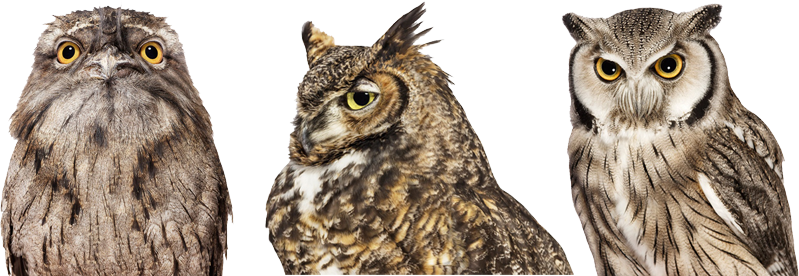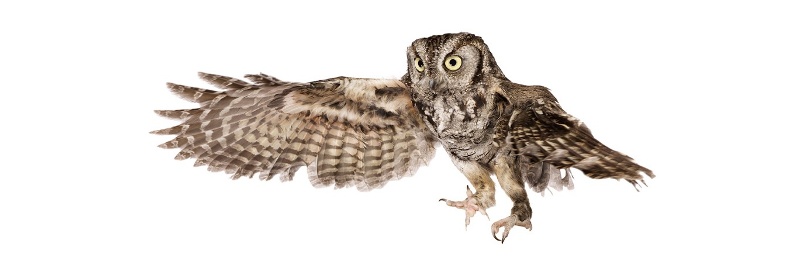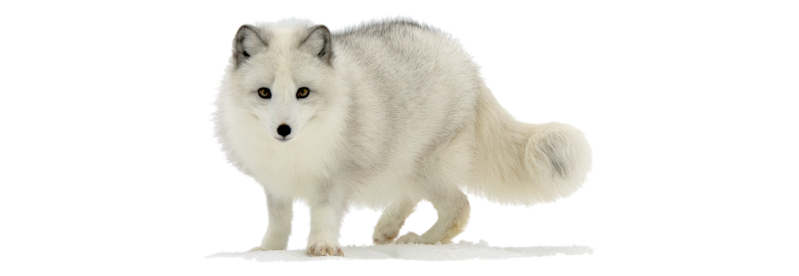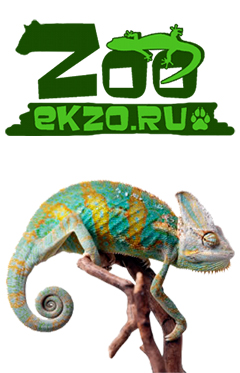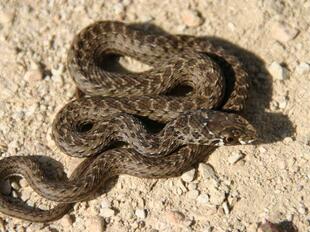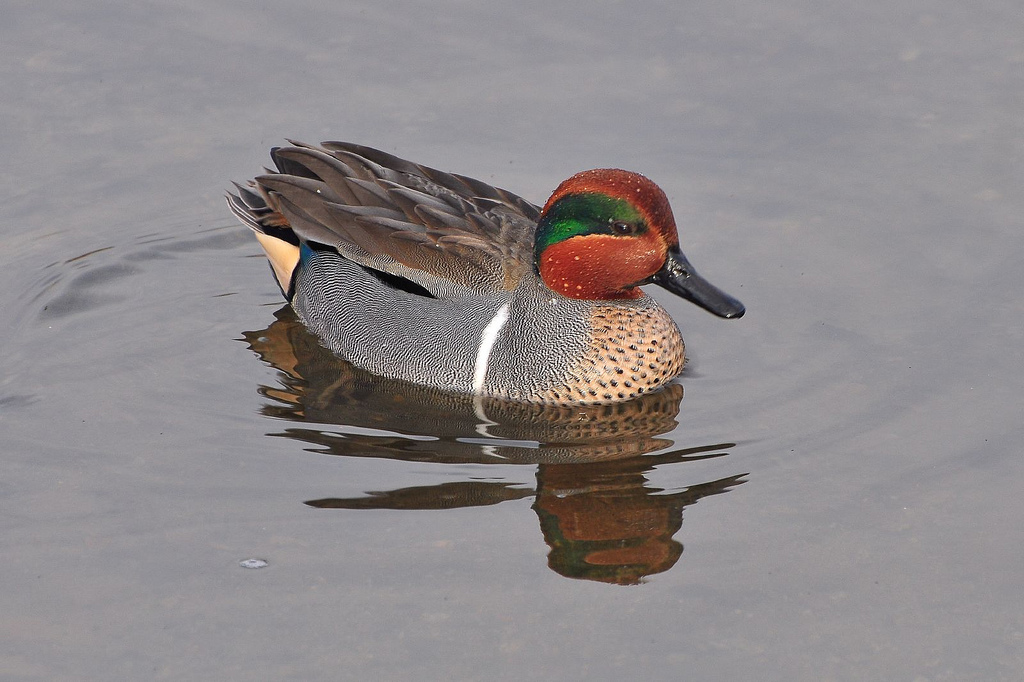
Eurasian teal, or Common teal(Anas crecca)
Phylum —chordata
Class — aves
Order — anseriformes
Family — anatidae
Genus –anas
Appearance
The Eurasian teal is one of the smallest extant dabbling ducks at 34–43 cm (13–17 in) length and with an average weight of 360 g (13 oz) in drake (males) and 340 g (12 oz) in hens (females). The wings are 17.5–20.4 cm (6.9–8.0 in) long, yielding a wingspan of 53–59 cm (21–23 in).
From a distance, the drakes in nuptial plumage appear grey, with a dark head, a yellowish behind, and a white stripe running along the flanks. Their head and upper neck is chestnut, with a wide and iridescent dark green patch of half-moon- or teardrop-shape that starts immediately before the eye and arcs to the upper hindneck. The patch is bordered with thin yellowish-white lines, and a single line of that color extends from the patch's forward end, curving along the base of the bill. The breast is buff with small round brown spots. The center of the belly is white, and the rest of the body plumage is mostly white with thin and dense blackish vermiculations, appearing medium grey even at a short distance. The outer scapular feathers are white, with a black border to the outer vanes, and form the white side-stripe when the bird is in resting position. The primary remiges are dark greyish brown; the speculum feathers are iridescent blackish-green with white tips, and form the speculum together with the yellowish-white tips of the larger upperwing coverts (which are otherwise grey). The underwing is whitish, with grey remiges, dense dark spotting on the inner coverts and a dark leading edge. The tail and tail coverts are black, with a bright yellowish-buff triangular patch in the center of the coverts at each side.
In non-breeding (eclipse) plumage, the drake looks more like the hen; it is more uniform in color, with a dark head and vestigial facial markings. The hen itself is yellowish-brown, somewhat darker on wings and back. It has a dark greyish-brown upper head, hindneck, eyestripe and feather pattern. The pattern is dense short streaks on the head and neck, and scaly spots on the rest of the body. The wings are colored similar to the drake's, but with brown instead of grey upperwing coverts that have less wide tips, and wider tips of the speculum feathers. The hen's rectrices have yellowish-white tips; the midbelly is whitish with some dark streaking.
The drake's bill is dark grey, in eclipse plumage often with some light greenish or brownish hue at the base. The bill of hens and immatures is pinkish or yellowish at the base, becoming dark grey towards the tip; the grey expands basewards as the birds age. The feet are dark grey in males and greyish olive or greyish-brown in females and immatures. The iris is always brown.
Moults during summer. Male in eclipse resembles female, but with darker upperparts and grey bill. Flight feathers are moulted simultaneously and birds are flightless for up to 4 weeks.
Habitat
The Eurasian teal breeds across the Palearctic and mostly winters well south of its breeding range. However, in the milder climate of temperate Europe, the summer and winter ranges overlap.
In winter, there are high densities around the Mediterranean, including the entire Iberian Peninsula and extending west to Mauretania; on Japan and Taiwan; as well as in South Asia. Other important wintering locations include almost the entire length of the Nile Valley, the Near East and Persian Gulf region, the mountain ranges of northern Iran, and South Korea and continental East and Southeast Asia.
Behavior
This duck is highly gregarious outside of the breeding season and will form large flocks. In flight, the fast, twisting flocks resemble waders; despite its short legs, it is also rather nimble on the ground by ducks' standards.
Diet
The Eurasian teal feeds on a wide range of aquatic food items including plant material such as aquatic plants, grasses and sedges, and grain, mainly cereals and rice during winter. During the breeding season, it feeds primarily on aquatic insects, larvae, mollusks, crustaceans and even fish eggs.
Reproduction
The pair-bond is often formed between late January and March. They are monogamous, but the pair-bond is broken each year. Males often outnumber females, involving some extra-pair copulations and frequent aggressive encounters between rivals. The displaying male makes jerky movements while on the water, often interspersed with spectacular aerial chases above pools and marshes where it breeds. After these elaborate displays, the female performs inciting display close to the chosen male. Both mates perform head-pumping before to copulate on the water.
The breeding season takes place in spring/summer, from March/May to at least July in the northern range. The Eurasian teal breeds in single pairs or loose groups. The female chooses a well-concealed site for the nest, usually among thick vegetation in sedges or grasses. The nest is a scrape or a natural depression on the ground. She builds a bowl with grasses, twigs and leaves. She usually adds some of her body’s down and feathers. The nest is concealed from predators by the surrounding vegetation that forms a kind of canopy. The nest is built on dry ground or upland moor, usually close to water.
The female lays 10-12 creamy-white eggs and incubates alone while the male abandons her and starts to moult. She incubates during 21-23 days. At hatching, the chicks have dark brown down above and yellow below. The female moves them to water very soon after hatching and she rears them alone. She broods them during the wet and cold periods. The young fledge about 25-35 days after hatching. They can breed at one year old.
In captivity
Lifespan in captivity is up to 30 years.
It is not difficult to keep Eurasian teals. In summer, teals are kept in outdoor enclosures. The minimum size of the enclosure is 3 square meters.
In the cold season, birds are kept in sections of the poultry house. Access to paddocks is open only on warm, windless, sunny days and only during the daytime.
Wild ducks become restless in the fall, when they fly south seasonally, and may join other wild ducks and fly away with them, so you should trim their wings in time or restrict access to walking. You can also cover the paddock with a net.
For winter keeping of ducks any shed (paddock) in which they are protected from wind and precipitation is suitable. The pen for ducks is built in such a way that one duck has at least 1 sq. m. of area with a room of the height of 70-100 cm. Ducks are not afraid of the cold; if they are full, clean and healthy, they can easily live at any frost.
The area of the paddock should not be less than the area of the paddock shed itself. One duck needs a range of 4 sq. m.In this case, all winter it is necessary to maintain a sufficient mirror of the reservoir for birds, not covered with ice. This is achieved in various ways, one of which may be the use of an air compressor. Long hoses from the compressor that pumps air are lowered to the bottom of the reservoir, and air bubbles, rising up, carry warmer water. With constant mixing of warm water from the lower layers of the reservoir with colder water from the surface, the possibility of ice formation is eliminated even in the most severe frosts.
As a winter bedding for waterfowl, you can use soft hay, which is laid out in places where birds rest.
The diet includes grain feed-corn, wheat, barley, millet, oatmeal, wheat bran, grass, meat and fish meal, chalk, small shell, gammarus. In the warm season, it is good to give various greens - cut dandelion leaves, lettuce, plantain, duckweed. Good food for ducks - wet mixture of grated carrots, bran, various cereals. During the reproductive period and during molting, they are mixed with wet food or given separately: fish and minced meat.During working out a diet it should be calculated that the amount of raw protein does not exceed 18-19%.
Eurasian teals are friendly to other birds, so they can be kept on the same pond with other ducks.
Artificial shelters for nests are installed in the paddock. Ducks independently incubate, breed and raise young ducklings.
 Russian
Russian
 English
English








